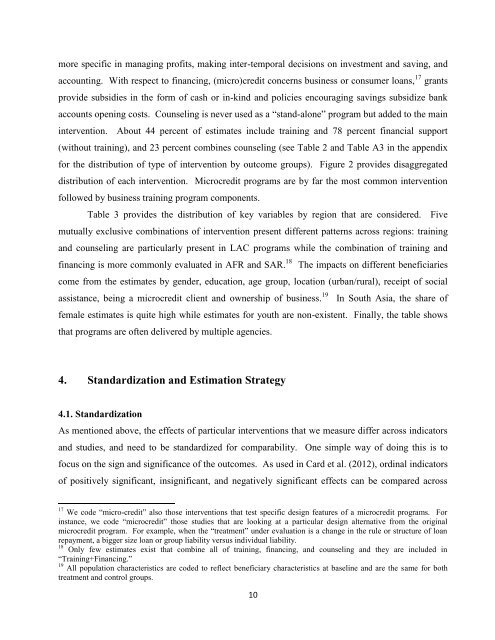Entrepreneurship Programs in Developing Countries: A ... - IYFLive.net
Entrepreneurship Programs in Developing Countries: A ... - IYFLive.net
Entrepreneurship Programs in Developing Countries: A ... - IYFLive.net
Create successful ePaper yourself
Turn your PDF publications into a flip-book with our unique Google optimized e-Paper software.
more specific <strong>in</strong> manag<strong>in</strong>g profits, mak<strong>in</strong>g <strong>in</strong>ter-temporal decisions on <strong>in</strong>vestment and sav<strong>in</strong>g, andaccount<strong>in</strong>g. With respect to f<strong>in</strong>anc<strong>in</strong>g, (micro)credit concerns bus<strong>in</strong>ess or consumer loans, 17 grantsprovide subsidies <strong>in</strong> the form of cash or <strong>in</strong>-k<strong>in</strong>d and policies encourag<strong>in</strong>g sav<strong>in</strong>gs subsidize bankaccounts open<strong>in</strong>g costs. Counsel<strong>in</strong>g is never used as a “stand-alone” program but added to the ma<strong>in</strong><strong>in</strong>tervention. About 44 percent of estimates <strong>in</strong>clude tra<strong>in</strong><strong>in</strong>g and 78 percent f<strong>in</strong>ancial support(without tra<strong>in</strong><strong>in</strong>g), and 23 percent comb<strong>in</strong>es counsel<strong>in</strong>g (see Table 2 and Table A3 <strong>in</strong> the appendixfor the distribution of type of <strong>in</strong>tervention by outcome groups). Figure 2 provides disaggregateddistribution of each <strong>in</strong>tervention. Microcredit programs are by far the most common <strong>in</strong>terventionfollowed by bus<strong>in</strong>ess tra<strong>in</strong><strong>in</strong>g program components.Table 3 provides the distribution of key variables by region that are considered. Fivemutually exclusive comb<strong>in</strong>ations of <strong>in</strong>tervention present different patterns across regions: tra<strong>in</strong><strong>in</strong>gand counsel<strong>in</strong>g are particularly present <strong>in</strong> LAC programs while the comb<strong>in</strong>ation of tra<strong>in</strong><strong>in</strong>g andf<strong>in</strong>anc<strong>in</strong>g is more commonly evaluated <strong>in</strong> AFR and SAR. 18 The impacts on different beneficiariescome from the estimates by gender, education, age group, location (urban/rural), receipt of socialassistance, be<strong>in</strong>g a microcredit client and ownership of bus<strong>in</strong>ess. 19 In South Asia, the share offemale estimates is quite high while estimates for youth are non-existent. F<strong>in</strong>ally, the table showsthat programs are often delivered by multiple agencies.4. Standardization and Estimation Strategy4.1. StandardizationAs mentioned above, the effects of particular <strong>in</strong>terventions that we measure differ across <strong>in</strong>dicatorsand studies, and need to be standardized for comparability. One simple way of do<strong>in</strong>g this is tofocus on the sign and significance of the outcomes. As used <strong>in</strong> Card et al. (2012), ord<strong>in</strong>al <strong>in</strong>dicatorsof positively significant, <strong>in</strong>significant, and negatively significant effects can be compared across17 We code “micro-credit” also those <strong>in</strong>terventions that test specific design features of a microcredit programs. For<strong>in</strong>stance, we code “microcredit” those studies that are look<strong>in</strong>g at a particular design alternative from the orig<strong>in</strong>almicrocredit program. For example, when the “treatment” under evaluation is a change <strong>in</strong> the rule or structure of loanrepayment, a bigger size loan or group liability versus <strong>in</strong>dividual liability.18 Only few estimates exist that comb<strong>in</strong>e all of tra<strong>in</strong><strong>in</strong>g, f<strong>in</strong>anc<strong>in</strong>g, and counsel<strong>in</strong>g and they are <strong>in</strong>cluded <strong>in</strong>“Tra<strong>in</strong><strong>in</strong>g+F<strong>in</strong>anc<strong>in</strong>g.”19 All population characteristics are coded to reflect beneficiary characteristics at basel<strong>in</strong>e and are the same for bothtreatment and control groups.10
















